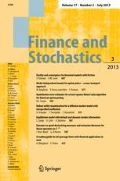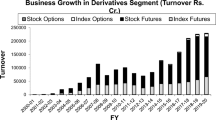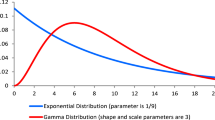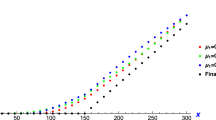Abstract
We study the set of Davis (marginal utility-based) prices of a financial derivative in the case where the investor has a non-replicable random endowment. We give a new characterisation of the set of all such prices, and provide an example showing that even in the simplest of settings – such as Samuelson’s geometric Brownian motion model –, the interval of Davis prices is often a non-degenerate subinterval of the set of all no-arbitrage prices. This is in stark contrast to the case with a constant or replicable endowment where non-uniqueness of Davis prices is exceptional. We provide formulas for the endpoints of these intervals and illustrate the theory with several examples.
Similar content being viewed by others
Notes
The theory of Davis pricing is simpler for utility functions, such as the exponential utility, defined on ℝ. For example, in any such model, Davis prices are unique because Bellini and Frittelli [2] have shown that the dual utility minimiser is a countably additive probability measure.
We thank our AE and a referee for this suggestion.
References
Becherer, D.: Utility indifference valuation. In: Cont, R. (ed.) Encyclopedia of Quantitative Finance, pp. 1854–1860. Wiley, New York (2010)
Bellini, F., Frittelli, M.: On the existence of minimax martingale measures. Math. Finance 12, 1–21 (2003)
Björk, T., Slinko, I.: Towards a general theory of good-deal bounds. Rev. Finance 10, 221–260 (2006)
Carmona, R.: Indifference Pricing: Theory and Applications. Princeton University Press, Princeton (2009)
Shiryaev, A., Cherny, A.: Vector stochastic integrals and the fundamental theorems of asset pricing. Proc. Steklov Math. Inst. 237, 12–56 (2002)
Cochrane, J., Saá-Requejo, J.: Beyond arbitrage: good-deal asset price bounds in incomplete markets. J. Polit. Econ. 108, 79–119 (2000)
Cvitanić, J., Schachermayer, W., Wang, H.: Utility maximization in incomplete markets with random endowment. Finance Stoch. 5, 237–259 (2001)
Cvitanić, J., Schachermayer, W., Wang, H.: Erratum to: Utility maximization in incomplete markets with random endowment. Finance Stoch. 21, 867–872 (2017)
Davis, M.: Option pricing in incomplete markets. In: Dempster, M.A.H., Pliska, S.R. (eds.) Mathematics of Derivative Securities, pp. 216–226. Cambridge University Press, New York (1997)
Delbaen, F., Schachermayer, W.: A general version of the fundamental theorem of asset pricing. Math. Ann. 300, 463–520 (1994)
Delbaen, F., Schachermayer, W.: A simple counterexample to several problems in the theory of asset pricing. Math. Finance 8, 1–11 (1998)
Duffie, D.: Dynamic Asset Pricing Theory, 3rd edn. Princeton Press (2001)
Dunford, N., Schwartz, J.T.: Linear Operators. Part I. Wiley, New York (1988)
Gu, L., Lin, Y., Yang, J.: On the dual problem of utility maximization in incomplete markets. Stoch. Process. Appl. 126, 1019–1035 (2016)
Föllmer, H., Schied, A.: Stochastic Finance, 4th edn. De Gruyter Studies in Mathematics. De Gruyter, Berlin (2016)
Föllmer, H., Schweizer, M.: The minimal martingale measure. In: Cont, R. (ed.) Encyclopedia of Quantitative Finance, pp. 1200–1204. Wiley, New York (2010)
Hicks, J.R.: A Revision of Demand Theory. Oxford University Press, London (1956)
Hiriart-Urruty, J.-B., Lemaréchal, C.: Fundamentals of Convex Analysis. Springer, Berlin (2001)
Hugonnier, J., Kramkov, D.: Optimal investment with random endowments in incomplete markets. Ann. Appl. Probab. 14, 845–864 (2004)
Hugonnier, J., Kramkov, D., Schachermayer, W.: On utility based pricing of contingent claims in incomplete markets. Math. Finance 15, 203–212 (2005)
Karatzas, I., Žitković, G.: Optimal consumption from investment and random endowment in incomplete semimartingale markets. Ann. Probab. 31, 1821–1858 (2003)
Kraft, H.: Optimal portfolios and Heston’s stochastic volatility model: an explicit solution for power utility. Quant. Finance 5, 303–313 (2005)
Kramkov, D., Schachermayer, W.: The asymptotic elasticity of utility functions and optimal investment in incomplete markets. Ann. Appl. Probab. 9, 904–950 (1999)
Kramkov, D., Sîrbu, M.: Sensitivity analysis of utility based prices and risk-tolerance wealth processes. Ann. Appl. Probab. 16, 2140–2194 (2006)
Kramkov, D., Weston, K.: Muckenhoupt’s (\(A_{p}\)) condition and the existence of the optimal martingale measure. Stoch. Process. Appl. 126, 2615–2633 (2016)
Kim, T.S., Omberg, E.: Dynamic nonmyopic portfolio behavior. Rev. Financ. Stud. 9, 141–161 (1996)
Larsen, K.: Continuity of utility-maximization with respect to preferences. Math. Finance 19, 237–250 (2009)
Larsen, K., Soner, H.M., Žitković, G.: Facelifting in utility maximization. Finance Stoch. 20, 99–121 (2016)
Larsen, K., Žitković, G.: Utility maximization under convex portfolio constraints. Ann. Appl. Probab. 23, 665–692 (2013)
Larsen, K., Žitković, G.: Stability of utility-maximization in incomplete markets. Stoch. Process. Appl. 117, 1642–1662 (2007)
Mas-Colell, A., Whinston, M.D., Green, J.R.: Microeconomic Theory. Oxford University Press, London (1995)
Munk, C.: The valuation of contingent claims under portfolio constraints: reservation buying and selling prices. Eur. Finance Rev. 3, 347–388 (1999)
Owen, M., Žitković, G.: Optimal investment with an unbounded random endowment and utility based pricing. Math. Finance 19, 129–159 (2009)
Siorpaes, P.: Do arbitrage-free prices come from utility maximization? Math. Finance 26, 602–616 (2016)
Zălinescu, C.: Convex Analysis in General Vector Spaces. World Scientific, Singapore (2002)
Wojtaszczyk, P.: Banach Spaces for Analysts. Cambridge University Press, Cambridge (1996)
Author information
Authors and Affiliations
Corresponding author
Additional information
Dedicated to the memory of Mark Davis.
Publisher’s Note
Springer Nature remains neutral with regard to jurisdictional claims in published maps and institutional affiliations.
The authors would like to thank Martin Schweizer, Pietro Siorpaes, Mihai Sîrbu, Kim Weston, our Co-Editor Alex Schied, and our anonymous AE and reviewers for numerous and helpful suggestions. During the preparation of this work, the first author has been supported by the National Science Foundation under Grant No. DMS-1411809 (2014–2017) and Grant No. DMS-1812679 (2018–2021), the second author has been supported by the Swiss National Foundation through the grant SNF \(200021\_153555\) and by the Swiss Finance Institute, and the third author has been supported by the National Science Foundation under Grant No. DMS-1107465 (2012–2017), Grant No. DMS-1516165 (2015–2018), and Grant No. DMS-1815017 (2018–2021). Any opinions, findings and conclusions or recommendations expressed in this material are those of the authors and do not necessarily reflect the views of the National Science Foundation (NSF).
Appendix A: Davis prices and related derivative prices
Appendix A: Davis prices and related derivative prices
The purpose of this appendix is to place the notion of Davis pricing within the wider framework of arbitrage- and utility-based pricing concepts. We start by noting that conditional Davis prices are always arbitrage-free in the sense of the following definition from Siorpaes [34, Sect. 2].
Definition A.1
A constant \(p = p(\varphi )\in {\mathbb{R}}\) is called an arbitrage-free price of \(\varphi \) if for all \(\pi \in {\mathcal{A}}\) and \(q'\in {\mathbb{R}}\), we have that
Proposition A.2
Given\(B\in {\mathbb{L}}^{\infty }_{++}\), each\(B\)-conditional Davis price\(p\)for a contingent claim\(\varphi \in {\mathbb{L}}^{\infty }\)is also an arbitrage-free price of\(\varphi \).
Proof
Let \(p\) be a conditional Davis price and suppose to the contrary of (A.1) that we can find \(q'\in {\mathbb{R}}\) and \(\pi \in {\mathcal{A}}\) such that the nonnegative random variable
is strictly positive with strictly positive probability, i.e., that we have \({\mathbb{P}}[A\geq 0]=1\) and \({\mathbb{P}}[A>0]>0\). Then for \(n\in {\mathbb{N}}\), the inequality (3.1) implies that
It remains to let \(n\to \infty \) and use the monotone convergence theorem to reach a contradiction with the fact that \(\mathfrak{U}(B)<\infty \). □
Next, we relate several popular utility-based pricing methods to Davis prices (see e.g. Becherer [1]). As always, \(B\in {\mathbb{L}}^{\infty }_{++}\) is the random endowment and \(\varphi \in {\mathbb{L}}^{\infty }\) is the claim’s payoff. However, we also allow a dependence on the quantity \(q\) of claims held.
Definition A.3
Let \(q\ne 0\). A constant \(m\) is called a utility-based derivative price for the payoff \(\varphi \) at quantity \(q\) if
A constant \(h=h(q) = h(q;\varphi |B)\) is called a utility indifference (Hicks, reservation) price for \(\varphi \) at quantity \(q\) if
Up to a sign convention, these prices are further divided into utility indifference buy and sell prices (see e.g. [4, Chap. 2]). Finally, a constant \(c = c(q) = c(q; \varphi |B)\) is called a certainty equivalent for \(\varphi \) at quantity \(q\) if
While the three concepts introduced above differ from each other in general, we show that under appropriate conditions, their limits as \(q\to 0\pm \) coincide with the endpoints of the interval \(P(\varphi |B)\) of conditional Davis prices.Footnote 3 To streamline the presentation, we define \(p_{\min }\) and \(p_{\max }\) by
Similarly, let \(m_{\min }(q) \leq m_{\max }(q)\) be the endpoints of the interval of utility-based derivative prices at quantity \(q\) defined in (A.2) above.
In Proposition A.4 below, we assume that both \(\varphi \) and \(B\) are positive, bounded and bounded away from zero. This entails virtually no loss of generality, but makes the value function \(u(x,q)\) defined in (4.1) strictly increasing in each argument. On the other hand, the assumption that \(-B\) is minimally superreplicable is a major one. We leave the question of the validity of Proposition A.4 without this for future research.
Proposition A.4
Suppose that Assumption4.5holds, \(B, \varphi \in {\mathbb{L}}^{\infty }_{++}\)and\(-B\)is minimally superreplicable. Then
and
Proof
We prove only (A.4) as the proof of (A.5) is completely analogous. Since the value function \(u\) from (4.1) is strictly increasing in each argument, \(h(q)\) and \(c(q)\) are well defined and unique for \(q\ne 0\). Moreover, we have for all \(q>0\) the bounds
Hence \(\lim _{q\searrow 0} q c(q)=0\) and we can let \(q\searrow 0\) in
and use Corollary 5.8 (where the constant \(y_{B}>0\) is defined) to obtain
It remains to use Proposition 4.1 to conclude that \(\lim _{q\searrow 0} c(q)\) is indeed the right endpoint of the interval of \(B\)-conditional Davis prices.
To deal with the indifference price \(h\), we use its definition together with the concavity of the value function \(u\) to conclude that for \(q>0\) and \(\lambda \in (0,1)\), we have
Since \(u\) is strictly increasing in its second argument, we have \(h(\lambda q) \geq h(q)\). Therefore \(q \mapsto h(q)\) is a nonincreasing function and by (A.6), its limit \(h(0+) := \lim _{q\searrow 0} h(q)\) exists in \((0,\infty )\). We use that fact to pass to the limit \(q\searrow 0\) in both sides of the equality
So the directional derivative of \(u\) at \((0,0)\) in the direction \((-h(0+),1)\) is 0, and
Corollary 5.8 implies that we have \((y,r) \in \partial u(0,0)\) only if \(y = y_{B}\), which then yields \(h(0+) = \frac{1}{y_{B}} \partial _{q+} u(0,0)\). Proposition 4.1 completes the argument.
Finally, we treat utility-based derivative prices. Let \((q_{n})_{n\in \mathbb{N}}\) be a sequence of positive numbers decreasing to 0 and define the sequence \((m_{n})_{n\in \mathbb{N}}\) by \(m_{n} := m_{\max }(q_{n})\). Because the lower endpoints \(m_{\min }(q_{n})\) can be treated similarly, we omit the details for that case. By (A.2), the concave function
admits a maximum at \(q'=q_{n}\). Therefore the partial derivatives of \(u\) at \((-m_{n} q_{n}, q_{n})\) are nonpositive in the directions \((-m_{n},1)\) and \((m_{n}, -1)\). The proof of Proposition 4.1 produces a pair \((y_{n}, r_{n}) \in \partial u( - m_{n} q_{n}, q_{n})\) such that \(r_{n} = m_{n} y_{n}\).
Because of (A.6), we have \(0< m_{n} \leq \operatorname{esssup} \varphi \) so that \((- m_{n} q_{n}, q_{n}) \to (0,0)\). The graph of the supergradient correspondence of a concave function is closed (see e.g. Hiriart-Urruty and Lemaréchal [18, Proposition 6.2.1]) and locally bounded (see e.g. [18, Proposition 6.2.2]). Therefore, by passing to a subsequence if necessary, we may conclude that \((y_{n}, r_{n}) \to (y^{*},r^{*})\) for some \((y^{*},r^{*}) \in \partial u(0,0)\). By Corollary 5.8, the value \(y^{*}\) must equal \(y_{B}>0\), and so \(y_{n}>0\) for large enough \(n\). This implies that \(m_{n} \to m\), where \(m=r^{*}/y_{B}\), and Proposition 4.1 guarantees that \(m\) is a Davis price for the payoff \(\varphi \).
On the other hand, for any conditional Davis price \(p \in P(\varphi |B)\) and for any \((y,r_{B})\in \partial u(0,0)\) such that \(p = r/y_{B}\), the monotonicity of the supergradient correspondence, i.e.,
see e.g. [18, Proposition 6.1.1], implies that
Since \(y_{n} \to y_{B}\), \(r_{n} \to r^{*}\) and \((m_{n})_{n\in \mathbb{N}}\) is a bounded sequence, we conclude that \(p = r/y_{B} \leq r^{*}/y_{B} = m\). Consequently, \(m = p_{\max }\).
It remains to show that \(m_{\max }(q) \to p_{\max }\) as \(q\to 0\). If it did not, there would exist a sequence \((q_{n})_{n\in \mathbb{N}}\) with \(q_{n} \searrow 0\) such that \(m_{\max }(q_{n}) \to p_{0}\ne p_{\max }\). The same would be true for any subsequence of \((q_{n})_{n\in \mathbb{N}}\), which contradicts the conclusion of the previous paragraph. □
Rights and permissions
About this article
Cite this article
Larsen, K., Soner, H.M. & Žitković, G. Conditional Davis pricing. Finance Stoch 24, 565–599 (2020). https://doi.org/10.1007/s00780-020-00424-5
Received:
Accepted:
Published:
Issue Date:
DOI: https://doi.org/10.1007/s00780-020-00424-5
Keywords
- Unspanned endowment
- Incomplete markets
- Utility maximisation
- Non-smoothness
- Marginal utility-based pricing




